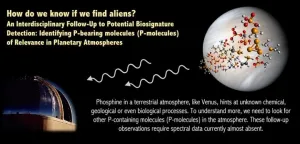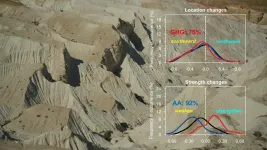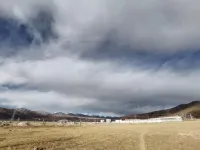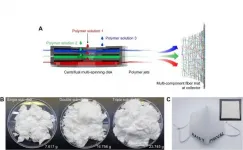(Press-News.org) The search for life on other planets has received a major boost after scientists revealed the spectral signatures of almost 1000 atmospheric molecules that may be involved in the production or consumption of phosphine, a study led by UNSW Sydney revealed.
Scientists have long conjectured that phosphine - a chemical compound made of one phosphorous atom surrounded by three hydrogen atoms (PH3) - may indicate evidence of life if found in the atmospheres of small rocky planets like our own, where it is produced by the biological activity of bacteria.
So when an international team of scientists last year claimed to have detected phosphine in the atmosphere of Venus, it raised the tantalising prospect of the first evidence of life on another planet - albeit the primitive, single-celled variety.
But not everyone was convinced, with some scientists questioning whether the phosphine in Venus's atmosphere was really produced by biological activity, or whether phosphine was detected at all.
Now an international team, led by UNSW Sydney scientists, has made a key contribution to this and any future searches for life on other planets by demonstrating how an initial detection of a potential biosignature must be followed by searches for related molecules.
In a paper published today in the journal Frontiers in Astronomy and Space Sciences, they described how the team used computer algorithms to produce a database of approximate infrared spectral barcodes for 958 molecular species containing phosphorous.
LOOK AND LEARN
As UNSW School of Chemistry's Dr Laura McKemmish explains, when scientists look for evidence of life on other planets, they don't need to go into space, they can simply point a telescope at the planet in question.
"To identify life on a planet, we need spectral data," she says.
"With the right spectral data, light from a planet can tell you what molecules are in the planet's atmosphere."
Phosphorus is an essential element for life, yet up until now, she says, astronomers could only look for one polyatomic phosphorus-containing molecule, phosphine.
"Phosphine is a very promising biosignature because it is only produced in tiny concentrations by natural processes. However, if we can't trace how it is produced or consumed, we can't answer the question of whether it is unusual chemistry or little green men who are producing phosphine on a planet," says Dr McKemmish.
To provide insight, Dr McKemmish brought together a large interdisciplinary team to understand how phosphorus behaves chemically, biologically and geologically and ask how this can be investigated remotely through atmospheric molecules alone.
"What was great about this study is that it brought together scientists from disparate fields - chemistry, biology, geology - to address these fundamental questions around the search for life elsewhere that one field alone could not answer," says astrobiologist and co-author on the study, Associate Professor Brendan Burns.
Dr McKemmish continues: "At the start, we looked for which phosphorous-bearing molecules - what we called P-molecules - are most important in atmospheres but it turns out very little is known. So we decided to look at a large number of P-molecules that could be found in the gas-phase which would otherwise go undetected by telescopes sensitive to infrared light."
Barcode data for new molecular species are normally produced for one molecule at a time, Dr McKemmish says, a process that often takes years. But the team involved in this research used what she calls "high-throughput computational quantum chemistry" to predict the spectra of 958 molecules within only a couple of weeks.
"Though this new dataset doesn't yet have the accuracy to enable new detections, it can help prevent misassignments by highlighting the potential for multiple molecular species having similar spectral barcodes - for example, at low resolution with some telescopes, water and alcohol could be indistinguishable.
"The data can also be used to rank how easy a molecule is to detect. For example, counter-intuitively, alien astronomers looking at Earth would find it much easier to detect 0.04% CO2 in our atmosphere than the 20% O2. This is because CO2 absorbs light much more strongly than O2 - this is actually what causes the greenhouse effect on Earth."
LIFE ON EXOPLANETS
Regardless of the outcomes from the debate about the existence of phosphine in Venus's atmosphere and the potential signs of life on the planet, this recent addition to the knowledge of what can be detected using telescopes will be important in the detection of potential signs of life on exoplanets - planets in other solar systems.
"The only way we're going to be able to look at exoplanets and see whether there's life there is to use spectral data collected by telescopes - that is our one and only tool," says Dr McKemmish.
"Our paper provides a novel scientific approach to following up the detection of potential biosignatures and has relevance to the study of astrochemistry within and outside the Solar System," says Dr McKemmish. "Further studies will rapidly improve the accuracy of the data and expand the range of molecules considered, paving the way for its use in future detections and identifications of molecules."
Fellow co-author and CSIRO astronomer Dr Chenoa Tremblay says the team's contribution will be beneficial as more powerful telescopes come online in the near future.
"This information has come at a critical time in astronomy," she says.
"A new infrared telescope called the James Web Space Telescope is due to launch later this year and it will be far more sensitive and cover more wavelengths than its predecessors like the Herschel Space Observatory. We will need this information at a very rapid rate to identify new molecules in the data."
She says although the team's work was focused on the vibrational motions of molecules detected with telescopes sensitive to infrared light, they are currently working to extend the technique to the radio wavelengths as well.
"This will be important for current and new telescopes like the upcoming Square Kilometre Array to be built in Western Australia."
INFORMATION:
The economies of northern Central Asia rely heavily on agriculture and are particularly affected by changes in the local hydrological cycle. However, this region is one of the largest dryland regions in the Northern Hemisphere and is facing a crisis of water resources shortage in recent decades. One example is the rapid desiccation and salinization of the Aral Sea. While the construction of dams, diversion of waterways and wasting of water have been blamed for the shortage, how climate change has influenced regional water resources remains unknown.
In a recently published research article in Geophysical Research Letters (drying trend over northern Central Asia), Jie Jiang and Tianjun Zhou from the Institute of Atmospheric Physics, Chinese ...
Clouds play a key role in balancing incoming and outgoing solar and thermal radiation. This is a critical process in the earth-atmosphere system. Monitoring cloud height, particle size, particle concentration, etc. are integral to understanding climate dynamics and global climate change. These physical attributes determine the radiative forcing effect of a cloud, or how much incoming radiation that a cloud reflects back to space. Satellites and ground-based radar can measure the cloud top height (CTH). However, inconsistencies exist between various satellites and radar data due to different detection methods and algorithms used to process raw information.
To quantify these conflicts, Bo Liu, jointly supervised by Dr. Juan Huo and Prof. Daren Lyu from Institute of Atmospheric ...
KAIST researchers have developed a novel nanofiber production technique called 'centrifugal multispinning' that will open the door for the safe and cost-effective mass production of high-performance polymer nanofibers. This new technique, which has shown up to a 300 times higher nanofiber production rate per hour than that of the conventional electrospinning method, has many potential applications including the development of face mask filters for coronavirus protection.
Nanofibers make good face mask filters because their mechanical interactions with aerosol particles give them a greater ability ...
Family history of early cardiac events in first degree relatives such as a parent or sibling is a major risk factor, especially for premature events. Currently, data on risks in close relatives of patients with a family history of premature heart attacks, chronic stable angina or peripheral vascular disease are sparse.
Researchers from Florida Atlantic University's Schmidt College of Medicine in collaboration with an international team of leading scientists in Italy, the United Kingdom and Poland, assembled a consecutive series of 230 patients with premature onset of heart attacks, strokes, angina or peripheral artery disease and a comparison group of apparently healthy men and women during a 24-month period. The comparison group had no family or ...
Breast cancer survivors who are overweight have a statistically significant increased risk of developing second primary cancers, according to results from a study conducted by Kaiser Permanente researchers and published in the Journal of the National Cancer Institute.
There are approximately 3.9 million breast cancer survivors in the United States today and studies have found women diagnosed with breast cancer have an 18% increased risk for developing a second cancer compared to the general population. This increased risk is likely due to shared risk factors between the first and second cancers, genetic susceptibility, and long-term effects of breast ...
COLUMBUS, Ohio - Men were more likely to be the spouse with the most knowledge of a couple's finances in 2016 than they were in 1992 - especially in wealthy couples, a new study suggests.
Results come from a survey that interviewed the spouse in mixed-sex married couples that was identified by a household member as "more knowledgeable about the household finances."
In 2016, 56% of husbands were designated as most knowledgeable, up from 53% in 1992 and 49% in 1995. But among households in the top 1% of net worth, the husband was designated as the most knowledgeable in 90% of the households in 2016.
"Despite the progress women have made in society, there still seems to be a gender gap in who takes care of the finances, especially in wealthy households," said ...
ATLANTA - APRIL 12, 2021 - New study finds higher medical financial hardship in adult survivors of adolescent and young adult (AYA) cancers than in adults without a history of cancer in the United States. The study appears in JNCI: The Journal of the National Cancer Institute.
Experts have known that cancer and its treatment can cause significant financial hardship to cancer survivors and their families. However, the long-term economic implications for adult survivors of AYA cancers were not fully understood. In this study, investigators led by Amy D. Lu, MD, The Hospital for Sick Children, and Zhiyuan "Jason" ...
Study: "Untested Admissions: Examining Changes in Application Behaviors and Student Demographics Under Test-Optional Policies"
Author: Christopher Bennett (Vanderbilt University)
This study was published today in American Educational Research Journal.
Key Findings:
In undergraduate admissions, the adoption of test-optional policies at selective private institutions was linked to a 3-4 percent increase in enrollment of Pell Grant recipients, a 10-12 percent increase in enrollment of first-time Black, Latinx, and Native students, and a 6-8 percent increase in enrollment of first-time students who were women.
However, these gains translate into only a 1 percentage point increase in the ...
Study: "Disproportionate Burden: Estimating the Cost of FAFSA Verification for Public Colleges and Universities"
Authors: Alberto Guzman-Alvarez (University of Pittsburgh), Lindsay C. Page (University of Pittsburgh)
This study was published today in Educational Evaluation and Policy Analysis.
Main Findings:
The institutional compliance costs of the FAFSA verification mandate in 2014 totaled nearly $500 million, with the burden falling disproportionately on public institutions and community colleges in particular.
Twenty-two percent of an average community college's financial aid office ...
Study: "21st Century Tracking and De Facto School Segregation: Excluding and Hoarding Access to College Prep"
Author: Heather E. Price (Marian University)
This study will be presented today at the AERA 2021 Virtual Annual Meeting.
Session: Schools and Social Policy: Segregation, Housing, and Transportation
Date/Time: Monday, April 12, 9:30 a.m. - 11:00 a.m. ET
Main Finding:
The prevalence of Black, non-Hispanic students in high schools that do not offer any AP or IB courses in multi-school districts that fund college-prep curricula cannot be explained by resource or school factors.
Details:
Using national data, this study examined how the ...




